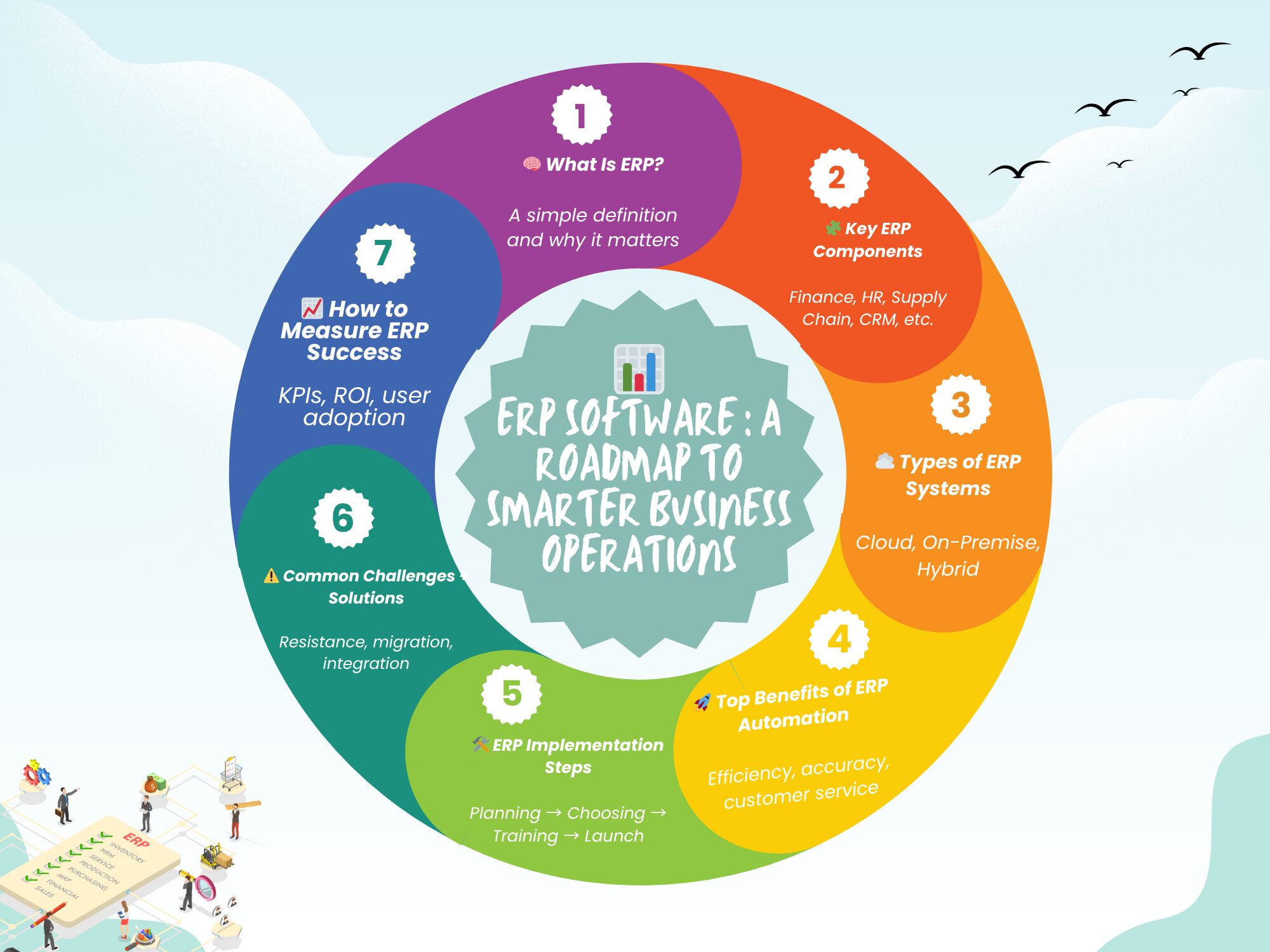Running a business today means juggling everything from inventory and payroll to customer orders and financial reporting. It’s a lot, and many business owners constantly feel like they’re one step behind. But here’s the key: companies with high employee engagement are 21% more profitable, and much of that comes from having the right systems in place to streamline daily operations.
That’s where ERP (Enterprise Resource Planning) software makes a difference. It centralizes your core business processes into one integrated system, saving time, reducing errors, and helping your team work smarter, not harder.
Understanding the Basics of ERP Software
What is ERP software is might seem like a complex question, but it’s actually quite straightforward. Think of ERP as the central nervous system of your business – it connects all your different departments and processes into one unified system.
The Core Definition and Purpose
An enterprise resource planning system is essentially a suite of integrated applications that manage your company’s day-to-day business activities. Instead of having separate systems for accounting, inventory, human resources, and customer management, ERP brings everything together under one roof.
Modern businesses are increasingly turning to erp automation solutions like those offered by Vic.ai, which integrate advanced AI technologies to eliminate manual data entry and streamline finance operations. These systems create bi-directional data sync with existing ERP platforms, ensuring real-time updates across all business functions.
Key Components That Make ERP Work
ERP software for businesses typically includes modules for financial management, supply chain operations, manufacturing, project management, and human resources. Each module talks to the others, sharing data instantly and creating a complete picture of your business operations.
The beauty lies in how these components work together. When your sales team closes a deal, the system automatically updates inventory levels, triggers production schedules, and adjusts financial forecasts. It’s like having a perfectly choreographed dance where every step flows naturally into the next.
Types of ERP Systems Available Today
Different businesses need different solutions, and ERP systems come in various flavors to match those needs. Understanding your options helps you make better decisions about which path to take.
Cloud-Based ERP Solutions
Cloud ERP has become incredibly popular because it’s accessible from anywhere with an internet connection. You don’t need a massive IT infrastructure or dedicated servers sitting in your office. The software provider handles all the technical stuff while you focus on running your business.
These systems are typically more affordable upfront and scale easily as your company grows. Plus, updates happen automatically, so you’re always working with the latest features and security patches.
On-Premise ERP Systems
Some companies prefer keeping their ERP system on their own servers and infrastructure. This gives them complete control over their data and customization options, but it also means higher upfront costs and ongoing maintenance responsibilities.
On-premise solutions work well for larger organizations with specific security requirements or unique business processes that need extensive customization. However, they require significant IT resources to maintain properly.
Hybrid ERP Approaches
Many businesses are finding success with hybrid models that combine cloud and on-premise elements. This approach lets you keep sensitive data on-site while taking advantage of cloud flexibility for other functions.
The Benefits of Automated ERP Systems
The benefits of automated erp systems go far beyond just organizing your data. They fundamentally change how your business operates and competes in the marketplace.
Improved Operational Efficiency
Automation eliminates repetitive tasks that eat up your employees’ time. Instead of manually entering data across multiple systems, information flows automatically from one department to another. This reduces errors and frees up your team to focus on more strategic work.
When processes run smoother, employees feel more confident and engaged in their roles. They’re not fighting against clunky systems or wasting time on data entry – they’re actually contributing to business growth.
Enhanced Data Accuracy and Reporting
Having all your business data in one place creates incredible opportunities for better decision-making. Real-time reporting gives you instant visibility into what’s happening across your organization, from cash flow to inventory levels to employee performance.
The days of waiting for monthly reports or piecing together information from different systems are over. You can spot trends, identify problems, and capitalize on opportunities as they happen.
Better Customer Service Capabilities
When your team has complete customer information at their fingertips, they can provide much better service. Order history, preferences, past issues – everything is right there when a customer calls or visits your website.
This comprehensive view helps you anticipate customer needs and resolve issues more quickly. Happy customers become repeat customers, and repeat customers drive profitable growth.
Essential ERP Implementation Guide
Implementing ERP software successfully requires careful planning and execution. Many projects fail because businesses underestimate the complexity involved, but following proven strategies dramatically improves your chances of success.
Planning and Preparation Phase
Start by clearly defining what you want to achieve with your ERP system. Are you trying to reduce costs, improve customer service, or support business growth? Having specific goals helps you evaluate different solutions and measure success later.
Get your team involved early in the process. The people who’ll use the system daily should have input on features and workflows. Their buy-in is crucial for successful adoption across your organization.
Choosing the Right Solution
Not all ERP systems are created equal. Consider factors like your industry requirements, company size, budget constraints, and growth plans. A system that works perfectly for a manufacturing company might be completely wrong for a service business.
Don’t just look at features – consider the vendor’s support quality, implementation track record, and long-term viability. You’re not just buying software; you’re entering into a partnership that should last for years.
Managing the Implementation Process
According to the Small Business Administration, proper project management is essential for successful technology implementations. Set realistic timelines, allocate adequate resources, and maintain clear communication throughout the process.
Train your team thoroughly before going live. The best ERP system in the world won’t help if your employees don’t know how to use it effectively. Plan for multiple training sessions and ongoing support.
Common Challenges and Solutions
ERP implementations aren’t always smooth sailing. Understanding potential obstacles helps you prepare and respond effectively when issues arise.
User Adoption Resistance
Change is hard, especially when it affects daily work routines. Some employees might resist the new system because they’re comfortable with existing processes or worried about job security.
Address these concerns directly through clear communication about benefits and comprehensive training programs. Show people how the new system will make their jobs easier, not harder.
Data Migration Complexities
Moving data from old systems to your new ERP platform can be tricky. Inconsistent formats, duplicate records, and missing information create headaches during the transition process.
Clean up your data before migration begins. It’s worth investing time upfront to ensure you’re starting with accurate, complete information in your new system.
Integration Requirements
Your ERP system needs to work well with other software your business uses. Poor integration creates data silos and reduces the system’s effectiveness.
Choose solutions with robust API capabilities and proven integration track records. Consider working with experienced consultants who understand integration challenges in your industry.
Measuring ERP Success
Once your system is running, you need ways to measure whether it’s delivering the promised benefits. Success metrics should align with your original implementation goals.
Key Performance Indicators
Track metrics like order processing time, inventory turnover, customer satisfaction scores, and employee productivity. These numbers tell you whether your ERP investment is paying off.
Don’t expect immediate results. It often takes several months for employees to become fully comfortable with new systems and for process improvements to show up in your metrics.
Return on Investment Analysis
Calculate both hard and soft benefits from your ERP implementation. Hard benefits include cost savings and efficiency gains, while soft benefits might include improved employee satisfaction and better decision-making capabilities.
Remember that ERP benefits often compound over time. A system that provides modest improvements in year one might deliver significant advantages as your team becomes more proficient and your business grows.
Your Questions About ERP Software Answered
1. What’s the typical timeline for ERP implementation?
Most ERP implementations take 6-18 months depending on company size, complexity, and customization requirements. Smaller businesses often complete implementations faster than larger organizations.
2. How much should we budget for ERP software?
ERP costs vary widely based on features, user count, and deployment method. Cloud solutions typically cost $50-200 per user monthly, while on-premise systems require larger upfront investments.
3. Can small businesses benefit from ERP systems?
Absolutely! Modern ERP solutions are designed for businesses of all sizes. Many cloud-based options offer scalable pricing and features that grow with your company.




































